| Family Origins |
The Gorman family dates back nearly as far as the history of Ireland itself,
and the twists and travails of it’s own history mirror that of Ireland. If
the Irish genealogists of the Middle Ages (namely the Catholic monks in monasteries
throughout the country) are to be believed, at the root of virtually every Irish surname lies royalty. Similarly, at the root of all royalty lies the origin of
man itself, Adam and Eve. At its heart, this may seem like reason enough to
document family histories, but they had others. In a patriarchic social structure
as was Ireland at that time, an heir’s right to land and property hinged on
a well preserved and recorded family genealogy to prove his birthright. As
a consequence, most families had their own Shanachy, or historian,
who recorded the family genealogy and historic events into an annal. These
annals would later be transcribed and compiled into larger volumes by the
monks as a record of noble families in their area. The most significant of
these are:
- Annals of Tighernach by Tighernach O'Breen (d. 1088), abbot of
Clonmacnoise and Roscommon.
- Annals of Innisfallen, 1215 by scholars of the monastery
of Innisfallen.
- Annals of Ulster by Cathal Maguire (d. 1498) on the island of Senait
Mac Manus, in Upper Lough Erne
- Annals of Lough Ce, 1588 by Bryan Mac Dermot, on the island of
Lough Key, in Roscommon.
- Annals of Connaught from 1224 to 1562.
- Chronicon Scotorum, 1650 by Duald Mac Firbis.
- Annals of Boyle, 1253.
- Annals of Clonmacnoise, English translation by Connell Mac Geoghegan
of Westmeath, 1627.
Occasionally, comprehensive compilations were produced which encompassed
the genealogies and histories of a much larger area, if not all of Ireland.
In the third century AD, Cormac Mac Art, 115th monarch of Ireland,
commissioned just such a compilation, the Psalter of Tara. Saints Patrick,
Benignus, Carioch, and others executed another in the fifth century. Cormac
Mac Cullinan produced another, the Psalter of Cashel, in the ninth
century. Finally, the Franciscan monk Michael O’Clery, with brothers Conary,
Cucogry and Ferfesa O'Mulconry, executed the largest work in 1632. Known as
the Annals of the Four Masters, it attempted to draw together previous
genealogies into a single, complete history and genealogy of the Irish nation.
It was translated into English and combined with other genealogies by O’Ferrall
in 1709, in what is known as the Linea Antiqua. In general, all modern
Irish genealogies reference some combination of all these. |
| The Uí Bairrche |
The Uí Bairrche was the original designation given
to the family or tribe, thought to be of Firbolg origin, that became the Gorman
and a number of other families (including O’Bracken, Mooney, and
Mead). Their genealogy is known from the Book of Glendalough, a medievel text from approximately A.D. 1130. The territory of the Ui Bairche was known as Crioch mBairce, what
is now the barony of Slievmargy, County Laois (Leix, or Queen’s County),
near County Carlow (see map). The original Uí Bairrche are said
to be related to the Brigantes tribe of northern Britain. They ruled southern
Leinster from the earliest centuries A.D. until the Uí Cheinnselaig
(the family line of Daire Barraig’s brother, Fiachu Ba h-Aiccid), broke
their power. Presumeably, this occurred after Crimthann mac Endai Cheinnselaig,
king of the Ui' Cheinnselaig, was killed by #94 O'engus
mac Ercae of the Ui' Bairrche in AD 492. At that time they were split
into at least two major groups, the Uí Bairrche of northern Carlow
(Ui Bairrche Maighe, which this lineage follows) and those of southern
Wexford (Ui Bairrche Tire).
The original ancestral land of the Uí Bairrche in
southern Leinster was occupied from the early Middle Ages until the Norman
Invasion in 1169. Following the Norman invasion, the clan MacGormáin
(which the Uí Bairrche adopted as their family surname) was evicted
from its lands due to their proximity to Dublin, the Norman stronghold
at that time. These lands were given over to the Preston family of England.
The O’Briens, who ruled the western province of Thomond (now County Clare),
granted the MacGormáins land in the Barony of Ibrickan, a rocky
and generally treeless coastal area south of the cliffs of Moher. Here,
they became marshals in the O’Brien’s army. They purportedly prospered
for four centuries and became known for their generosity in supporting
artists, poets and the general poor of the area. It was at this time that
the family adopted its coat of arms: an azure field, with a lion passing
between three erect swords. Its crest is an armored arm, with the hand
grasping a sword with a wavy blade. Their motto: First and Last in
War (in Gaelic Tosac cata a’s deire áir, or in Latin Primi et ultimi in bello). |
| Origins of the Gorman Surname |
It was common before the use of surnames for sons to append their father’s
name after theirs as a means of denoting paternity. As an example, in some
texts, #91 Feicc will be seen as Feicc Mac Dairé
Barraig (Feicc, son of Dairé Barraig). Surnames as we know them today
did not come into common usage until the rule of Brian Boru, A.D. 1002 – 1014.
The original Gaelic surname for the Gorman family was MacGormáin, Mac being the Gaelic equivalent to son of and Gormáin denoting the
color blue. It is thought that family members would have worn blue tunics
or cloaks, just as Scots are known to wear tartans to denote family affiliation.
The first documented MacGormáin to use his surname was #111
Murtach (also Muireadach), whose death is recorded by the Four
Masters as being in A.D. 1124. It is possible that the surname began
being used some generations before, possibly by #105
Dunagan, for he was the first son of a Gorman at the time when surnames
came into general use.
After the Act of Settlement of Ireland of 1661, all lands held by Mac
Gormáins in County Clare were given over to English landholders
and the formerly powerful Mac Gormáin family was reduced to serfdom
on their own lands. Charles II, King of England gave 1100 acres owned
by Malachy Mac Gormáin to Captain William Hamilton, presumably
as a reward for service to the crown. |
| The Penal Laws and Surname Anglicization |
| During the era of the Penal Laws, it became illegal for the Irish to use
the Mac prefix in their surnames, so it was dropped and the name was
anglicized. Every Mac Gormáin in County Clare became a Gorman. As restrictions
on the native Irish began to ease leading up to the Catholic Emancipation
in 1829, Gormans began to migrate east, mainly into County Tipperary. After
emancipation, most Clare Gormans chose to add the prefix O’ to their
surname, as knowledge of the original Mac prefix had been lost. O’ is an anglicized version of the Gaelic prefix Ui, as in Ui Bairrche,
which means "descended from" or "in the family of". Most
Gormans in County Tipperary retained the use of the Gorman surname. Currently,
the only place in Ireland where the surname MacGorman is used is in a small
area of County Monaghan, where they chose the correct prefix, but kept the
anglicized Gorman, rather than the Gaelic Gormáin. |
| Our "Royal Lineage" |
In seeking out the royalty in our past, it helps that the farther back in
time, the fewer people there were. The likelihood that an ancestor may have
ruled something, be it a tribe of dirt farmers or a country of millions, becomes
greater. But logic tells us that not everyone can be king. Additionally, not
all family genealogies are likely to have survived down through the ages.
Many of the great literary works undertaken by the monks of the middle ages
were destroyed or stolen by the marauding Vikings, including the Psalter
of Cashel, of which there is no copy today. The work of compiling what
fragments remain would have been a daunting task, especially for genealogists
working with a largely illiterate and dispersed population. Finally, if the
task was to show a genealogical line of succession from Adam and Eve to the
present day, it would have been impossible, for many of the biblical figures
(depending on your beliefs) are purely mythological. As a result, it is thought
that many of the genealogies written contain a large number of mythical characters
as bridges between the biblical periods and more recent history. The authenticity
of many sections must be treated with some skepticism. According to Michael
R. Davidson, a genealogist and historian from Edinburgh. Scotland:
"From the seventh century onwards, Irish monks were involved in manufacturing
a history for themselves to fill the gap between biblical history and (their)
modern history. As a result, any competent medieval Irish historian could
trace the supposed genealogy of any of the modern kings of Irish descent
back to Adam, through fabulous, then biblical antecedents. "
A true and complete Gorman family genealogy is, in fact, an impossibility.
Even if one could separate one’s self from any biblical trappings, he would
have to extend the lineage many thousands of years into human prehistory.
By definition, there is no history in pre-history. Geneticists trace the origin
of the human species through the mutation of mitochondrial DNA to a common
maternal ancestor said to have branched from chimpanzees some 222,000 years
ago. Needless to say, the likelihood that any written record of family lineage
that far back is remote. |
| The MacGormain/O’Gorman/Gorman Genealogy |
I am presenting here the lineage of the family of Purcell O'Gorman, a member of Parliament and son of the famous activist and barrister Nicholas Purcell O'Gorman. This list is compiled from a number
of different sources, the most significant of which is O’Hart (2). He contends
that, based on the ancient texts, the ancestry of the Gorman noble line descends
from one of the primary royal lineages in Ireland, the Faley O’Connors. They
in turn are descended through a long succession of kings, from Noah. According
to some accounts, all names preceding #95 in this list are entirely mythical.
We can assume that many more are as well.
Notes:
1. An alternative genealogy indicates that the lineage from
#12 Magog to #27 Febric Glas actually should follow the lineage of Magog’s
brother Gomer as follows:
- Japheth
- Gomer
- Riphath Scot
- Baath
- Esrú
- Srú (Iara)
- Ára (Aoth)
- Abuith (Ecthech)
- Aurthacht (Ethach)
- Máir
- Séim
- Boib
|
- Thóe
- Agnoman
- Fetheor
- Lámfind
- Glúnfind
- Éogan
- Fóenius Farsaid
- Nél Nemnach
- Gáedal Glas (Gathelus)
- Éber Scot
- Nenuall, etc.
|
2. The Gorman family exists on what is known as the "Line
of Heremon (Eremon)". According to legend, the leader of the fourth and
final wave of Celtic settlers in Ireland, Milesius, had three sons – Heremon,
Heber, and Ir, each of which founded the three primary family branches on
which every family descended from Celtic blood in Ireland lies. Heremon was
supposedly to have killed his brother Heber and ruled Ireland singly. Some
other families on the Line of Heremon are the Muldoon, Kavanagh, and O’Connor.
Some families on the Heber line are O’Neill, O’Sullivan, and O’Brien. Some
Ir line families are Healy, Mulcahy, and Reynolds.
3. The Gorman family is a branch of the family
O’Connor Faley, whose ancestral lands are in Offaley. This family branch extends
from the primary Line of Heremon starting at #60 Leghaire Lorc, 68th Monarch of Ireland.
4. #90 Daire Barraig, second son of Cathair Mór,
King of Leinster and 109th Monarch of Ireland, is considered the
first chief of the Ui Bairrche (sometimes Hy Bairrche, named for him).
He is presumed to have died around A.D. 487. The genealogy of the Uí
Bairrche as exerpted from The Annals of the Four Masters can be found
in Appendix 1. |
| Bibliography |
- Descent from Adam to Luke Joshua Stevens (website) by
Luke Stevens. http://geocities.com/Athens/Aegean/2444/descent.htm.
- O’Hart, John. Irish Pedigrees. ©1915, P. Murphy & Son, NY.
- Bartrum. Early Welsh Genealogical Tracts, A Welsh Classical Dictionary.
&"Pedigrees of the Welsh Tribal Patriarchs", National Library
of Wales Journal v.13.
- Celt Corpus of Electronic Texts (website). http://www.ucc.ie/celt/ © 1997 1998 Corpus of Electronic Texts (UCC).
- P.W. Joyce, M.A., LL.D., T.C.D.; M.R.I.A. A Smaller Social
History of Ancient Ireland. ©1908 M.H. Gill & Son, Ltd., Dublin.
Website: http://www.alia.ie/tirnanog/sochis/sochis01.html.
- The Tribes of Laigin, Leinster Series (website). http://www.fortunecity.com/bally/kilkenny/2/leinst2.htm
- Patrick Lavin. Ancestral Quest. © 1997 by Garryowen, Inc., Publishers.
- Index of Ireland Family Names and Al Beagan's "Genealogy
Notes©" (website). http://www.capecod.net/~abeagan/ireland.htm
- Edmond Gorman. The Records of Moycarkey and Two-Mile-Boris. ©1935.
- Samuel Lewis. Topographical Dictionary of Ireland. ©1838.
- Thomas Cahill. How the Irish Saved Civilization, 1995 by Doubleday
Books, New York, NY
|
< Back to Family Histories
|
|
| Images |

A fragment of the The Annals of Tigernach, A.D. 1088.
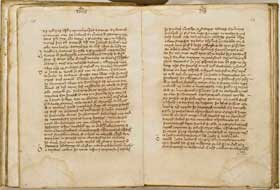
A two-page spread from the The Annals of The Four Masters, A.D. 1632.
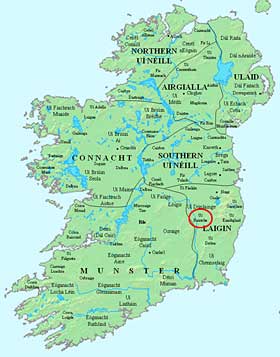
Map of Ireland showing the location of the clan Uí Bairrche (circled in red) around AD 800. Image courtesy wikipedia.com.
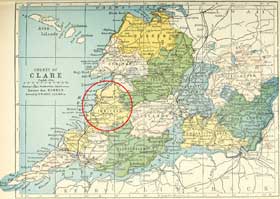
The Barony of Ibrickan (circled), County Clare
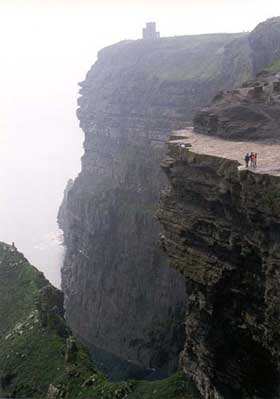
The Cliffs of Moher in west County Clare
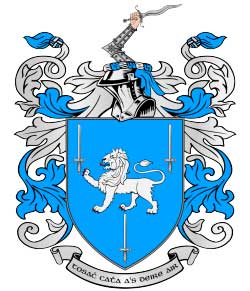
The MacGormáin/Gorman/O'Gorman family Crest and Coat of Arms
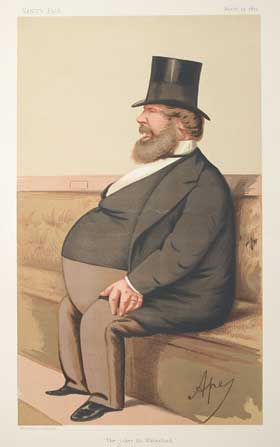
Purcell O'Gorman, as caricatured in Vanity Fair, March 13, 1875.
|
|